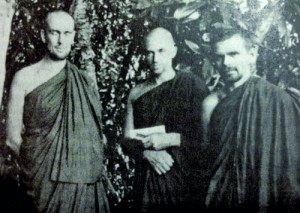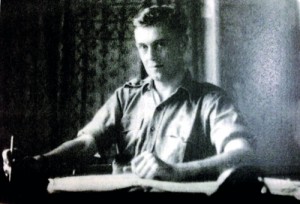Harold Edward Musson’s extraordinary journey to becoming Nanavira Thera
View(s):“Only in a vertical view, straight down into the abyss of his own personal existence, is a man capable of apprehending the perilous insecurity of his situation; and only a man who does apprehend this is prepared to listen to the Buddha’s Teaching.”
-Nanavira Thera
One day in 1948, almost a decade before the flower children’s exodus to the East, two Englishmen–one, 28, in the prime of life, and the other, 15 years his senior–arrived in Ceylon. They proceeded to Vajirarama in Colombo where they received the novice ordination and, eventually, the full ordination as Buddhist monks. The Hermit of Bundala (THB) by Bhikkhu Hiriko Nanasuci is the story of one of them–Harold Edward Musson.
The book traces Musson’s unusual life through numerous interviews and Musson’s and the other Englishman, Osbert Moor’s correspondence with their relatives, friends and fellow seekers of the Path. It is an engaging narrative of Musson’s extraordinary life: A childhood spent in an upper class English family, Cambridge days followed by a stint in an army intelligence unit during the Second World War, a decadent post-war interlude, a herculean effort to understand and follow the Buddha’s teaching, and his last days in a secluded kuti in the remote village of Bundala in the jungles of southern Ceylon.
Had that stark contrast of Musson’s beginning and end been the main story, The Hermit of Bundala would remain a book about an eccentric Englishman. It is much more. THB is the story of Nanavira Thera—as Musson was known post-ordination—and his single-minded quest to follow the Buddha’s teaching.
Nanavira’s magnum opus is Notes on Dhamma, a thin but formidable volume where he reinterprets some of the fundamental teachings of the Buddha which according to him were misunderstood due to the influence of the Buddhist commentarial tradition in Ceylon. “The commentaries are sometimes right-sometimes”. Two previous volumes, “Seeking the Path” and “Clearing the Path”, also published by Path Press Publications, provide many details of Nanavira’s quest to find the Buddha’s path. In the present work, Bhikkhu Nanasuchi has struck a subtle balance between the narrative of Nanavira’s biography and his insights into how to approach the Buddha’s teaching which makes it more accessible to a wider audience than previous Path Press publications.

Harold Musson in 1941 and top, Ven. Nanavira, Nanamoli and Nanavimala Theras at the Island Hermitage in 1953
The tracing of how Nanavira’s views changed as his understanding matured is especially interesting. Until his breakthrough understanding, Nanavira Thera struggled with how to approach the suttas constantly changing his views. For him the correct approach was essential to understand a teaching which the Buddha himself called “going against the stream”; “not accessible by logic”; “to be personally understood by the wise”.
By the time he arrived in Ceylon, Musson had settled on Theravada Buddhism as his point of departure. He learnt Pali and studied the suttas deeply. His studies and powers of reflection eventually forced him to set aside even some interpretations of the teaching taken as central by the established tradition in Ceylon. The Commentaries, the Abhidhamma, Visuddhimagga –all venerated texts—did not make the cut. This made him a heretic in the eyes of many. For a few —the number has grown with multiple publications of the Notes—he was a trailblazer who had cleared the Buddha’s path of deadwood accumulated over centuries.
At the beginning, Nanavira Thera studied the methods of many different disciplines including Eastern and Western philosophies. He singled out existentialism and phenomenology as a good starting point for the western mind for understanding the Buddha’s teaching. During this early period, Nanavira used Nanamoli Thera , as Osbert Moore was known post-ordination, as a sounding board to understand his own views better.
The objective, “scientific” approach to the Dhamma is still popular among many Buddhists. One of Nanavira Thera’s major contributions is the clarification that it is the subjective approach that yields the correct understanding. There are several instances in the suttas from which this can be inferred: the oft-repeated formula of six qualities of the Dhamma, i.e “to be understood personally by the wise”; from the Buddha’s quote “Both formerly and now, it is only dukkha that I describe, and the cessation of dukkha”; Buddha’s definition of the world: “ It is in this very fathom-long physical frame with its perceptions and mind, that, I declare, lies the world, and the arising of the world, and the cessation of the world, and the path leading to the cessation of the world” .
Having singled out several texts in the Sutta Pitaka, Nanavira Thera goes on to say “No other books whatsoever can be trusted. Leaving aside Vinaya, seek the meaning of these books in your own experience. Do not seek their meaning in any other books: if you do, you will be misled”.
His other key contribution is the interpretation of Dependent Origination (paticcasamuppada) outside of time, at a period when the “three-life” interpretation of it was considered the correct one. Dependent Origination is considered one of the two most difficult and central teachings of the Buddha (the other being Nibbana). K. Nanananda Bhikkhu, the author of Magic of the Mind , another thin and formidable book, comments: “Nanavira did reveal an important matter: the reciprocal relationship between vinnana (consciousness) and nama-rupa (name and form) is the vortex of existence, and it is the heart of paticcasamuppada”.
Nanavira’s insightful gems are scattered throughout the text. One of the difficulties for a novice is that in the suttas there seems to be no systematic development of the main concepts of the teaching: “that the Buddha deliberately taught the Dhamma in such a way that it is impossible to apply any method to it, thereby turning it into a System—a System can be accepted or rejected at will, but not the Dhamma” . Furthermore, Nanavira noted that in the suttas the same word can have multiple meanings corresponding to different levels of understanding. “This is the secondary reason why a method of interpretation—which, as a rationalization, depends upon logical argumentation, and thus upon each word having one meaning and one only—cannot be applied to the Suttas. The only way to find out what a Teaching in the Suttas means is to refer to one’s own experience. (The primary reason why method will not work is, of course, that all method depends upon the paticcasamuppada—it is phassapaccaya —and cannot therefore be applied to the paticcasamuppada, just as chemistry cannot deal with nuclear physics, upon which it depends.)”
Often, a person striving to follow the Buddha’s path is accused of being selfish. Why not help the multitudes who are less fortunate? “It is not a question between ‘being selfish’ and ‘being unselfish’, but understanding that whatever one chooses to do is still being selfish, regardless of how much one is socially active, i.e. all action is selfish. Time and again the Buddha points out that it is only those who have successfully devoted themselves to their own welfare and made sure of it (by reaching sotapatti) are then in a position to help others—one himself sinking in quicksand cannot help others to get out, and if he wishes to help them he must first get himself out…”
The narrative in THB provides a vignette of the life of Western Buddhist monks in Ceylon between 1950 and 1965, specially, of the life and inhabitants of the Island Hermitage in its heyday. One chapter is dedicated to a touching description of the poor villagers of Bundala; how they venerated the hermit and provided his daily meals according to their means. There is also a sketch of several intriguing incidents involving the early “Nanavirists” who tried to follow in the footsteps of the hermit of Bundala.
Ultimately, THB can be read at two quite different levels: either as an entertaining biography of an eccentric intellectual or as an invitation to look into the same deep questions about existence that propelled the protagonist of THB on his extraordinary journey. Which reading one finds will depend on the satisfaction or lack of it in one’s own “existence”.
| Book facts
“The Hermit of Bundala” by Bhikkhu Hiriko Nanasuci. Reviewed by Thusitha Jayawardena |


